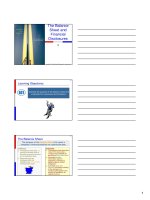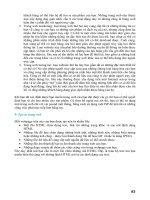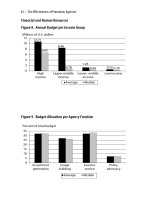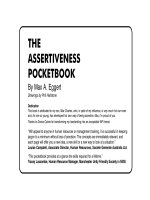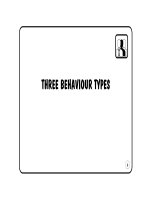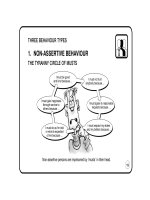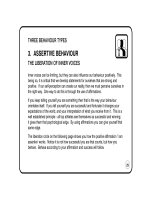THE BALANCE SHEET POCKET BOOK phần 7 ppt
Bạn đang xem bản rút gọn của tài liệu. Xem và tải ngay bản đầy đủ của tài liệu tại đây (81.97 KB, 11 trang )
THE BALANCE SHEET
COMMON MISCONCEPTIONS
‘The Balance Sheet tells me the value of the business.’
No. Remember the shareholders own the business and therefore the value of the
business is the cost of acquiring those shares, ie:
Number of shares x Share Price
There are many reasons why this is not the same as the Balance Sheet value of
Shareholders’ Funds. For instance, some of the business’s value does not
appear on the Balance Sheet, eg:
- Employee skills
- Market Opportunities
- Order Book
- Market value of Fixed Assets or Stocks
64
THE BALANCE SHEET
INTERNAL FORMAT
● The format examined to this point has addressed an internal report to
the Management Team
● The focus has been to consider the Management decisions in respect of the:
Use of Funds (Net Assets Employed)
made available to the business from a number of external sources:
Source of Funds (Net Capital Employed)
● Management must account for and make a return on the Net Capital Employed
● The Report provides essential management information
65
THE BALANCE SHEET
PUBLISHED FORMAT
The Balance Sheet
published format
A Report to the Owners of the Business
the Shareholders
● The published format is structured to feature the different needs of the Shareholders -
the owners of the business
● The Shareholder is seeking to trace that part of the business funded by the
Shareholders either through Share Capital or Reserves
● This change of end user requires a change of format only. The accounting terms
used to this point are retained with the same definitions
66
THE BALANCE SHEET
REPORTS TO THE SHAREHOLDERS
Internal Format
£’000
Fixed Assets 470
Current Assets 520
Less:
Current Liabilities 290
Working Capital 230
Net Assets Employed 700
Financed by:
Share Capital 300
Reserves 200
Shareholders’ Funds 500
Loan Capital 200
Net Capital Employed 700
67
Published Format
£’000
Fixed Assets 470
Current Assets 520
Less:
Current Liabilities 290
Net Current Assets 230
(Working Capital)
Total Assets less
Current Liabilities 700
Less:
Creditors/Loans
(greater than 1 year) 200
Total Net Assets 500
Capital and Reserves
Share Capital 300
Reserves 200
Shareholders’ Funds 500
THE BALANCE SHEET
PUBLISHED FORMAT
● In most companies the Balance Sheet is subject to external audit
(Note: different rules now apply for small companies)
● Current Liabilities includes all items due for payment within the next financial year
● Creditors and Loans (greater than one year) includes items of indebtedness
required to be paid in the future but not in the next 12 months
● The format provides summary information only - the report is supported with
detailed notes cross referenced to the Balance Sheet
● The format is required to show the comparative figures for the preceding year
68
SECTION 2
THE PROFIT AND LOSS ACCOUNT
Page
Introduction 70
Profit not Cash 73
Operating Profit 78
Financing Costs 82
Example 85
Published Format 90
69
PROFIT AND LOSS ACCOUNT
LINK BETWEEN FINANCIAL REPORTS
● Revenue performance is assessed in respect of a defined trading period
● The Balance Sheet provides a picture of the business investment at a specific
point in time, eg:
- at the start of the trading period
- and at the end of the trading period
● The Profit and Loss Account reports what happened, in terms of Revenue
Performance, between those Balance Sheet dates
70
PROFIT AND LOSS
ACCOUNT
"Revenue Performance"
BALANCE SHEET
"End Point"
BALANCE SHEET
"Start Point"
TRADING PERIOD
PROFIT AND LOSS ACCOUNT
DIFFERENT APPROACHES
Companies use many different formats and styles to report their revenue or profit
performance internally, eg:
● Trading Account ● Operating Statement ● Revenue Account, etc
Whatever the name, the statement will be reporting on some or all of this part
of the business model.
p44
71
PRODUCTS /
WORKING CAPITAL
Sales
Attributable Cost
Operating Profit
Interest
Tax
Earnings
Dividend
Retained Profits
Less:
Less:
Less:
PROFIT AND LOSS ACCOUNT
REVENUE PERFORMANCE
Hence the Profit and Loss Account is a statement of revenue performance over a given
period of time showing:
● The value of products or services sold - Sales
● The costs the business has incurred in meeting those sales
72
PROFIT AND LOSS ACCOUNT
PROFIT NOT CASH
The Profit and Loss Account measures the profit or loss made on the goods sold
during the period.
● It does not measure the cashflows into and out of the business
● This is an essential difference
● Cashflow is a vital part of the financial management of the business and is dealt
with separately in the Cashflow Statement
(see further The Managing Cashflow Pocketbook)
● To manage a business both Profit and Cash must be considered
73
PROFIT AND LOSS ACCOUNT
PROFIT NOT CASH
SALES
This is the value of product or
services sold during the period
(excluding Value Added Tax)
NOT
the amount of cash collected
(Any sales not yet paid for by
the customer will appear on the
Balance Sheet as Debtors/Receivables.)
74
